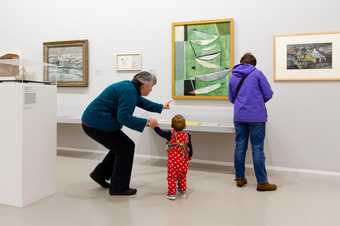Discover a range of artists who were working in West Cornwall during and immediately after the Second World War
This room includes a range of artists who were working in West Cornwall during and immediately after the Second World War.
In 1939 a number of modern artists, beginning with British painter Margaret Mellis and critic Adrian Stokes relocated to West Cornwall. Attracted by the
established community of marine and landscape painters, St Ives was also far enough from London to be a refuge from the imminent war. By the end of the year Barbara Hepworth, Ben Nicholson and Naum Gabo had joined them.
The war brought austerity and introspection to the town. Materials were scarce, working on the coast was forbidden and everyone was engaged in the war effort. Occasional visitors from London kept the modern artist circle in contact with the wider art world, including critic Herbert Read and patrons such as Margaret Gardiner who offered much needed financial support.
The arrival of Nicholson and particularly Gabo had an important influence on the younger generation of artists working in the town. For Peter Lanyon, John Wells, Bryan Wynter and Wilhelmina Barns-Graham they offered a direct link to international modern pioneers. New organisations emerged such as the Penwith Society of Arts in Cornwall and the decade to follow brought a stream of modern artists, writers and critical attention to the town.
In 1951 the Festival of Britain in London aimed to lift the spirits of a post-war nation. It celebrated the best of British arts, science and industry. Notably,
it brought exposure to modern British artists based in Cornwall, including Hepworth, Nicholson, Lanyon and Terry Frost.
Tate St Ives
Entry to both the display and the gallery is free for Tate Members, Locals' Pass holders and under 18s.

